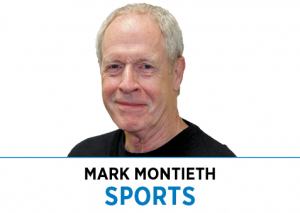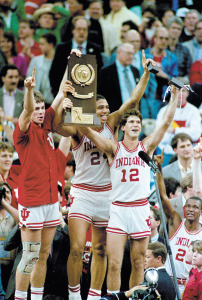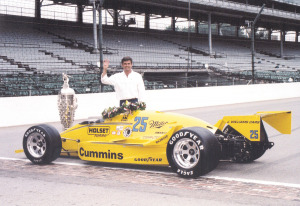Subscriber Benefit
As a subscriber you can listen to articles at work, in the car, or while you work out. Subscribe Now The harmonic convergence was a new-age event in August 1987 that was said to usher in an era of worldwide peace and harmony. Supposedly a rare alignment of the planets, with a boost from 144,000 people meditating in various “power centers,” would redirect the thought processes of people throughout the planet. Maybe attract aliens, too.
The harmonic convergence was a new-age event in August 1987 that was said to usher in an era of worldwide peace and harmony. Supposedly a rare alignment of the planets, with a boost from 144,000 people meditating in various “power centers,” would redirect the thought processes of people throughout the planet. Maybe attract aliens, too.
You might have noticed it didn’t quite work out that way.
Some kind of convergence did occur in 1987, however, at least in the realm of Indiana sports. That year stands far and away as the greatest ever for the state’s major sports teams. Apparently, the planets were aligned for winning championships, setting records and making history. It had nothing to do with meditating, but a lot to do with fans screaming.
Indianapolis Star columnist Bob Collins, an Indianapolis native and 40-year veteran of local sports reporting at the time, recognized it in the moment. “Cork it and put it in the cellar,” he wrote in his year-end column, adding, “If the state ever had a sports year like 1987, I must have slept through it.”
It was indeed a glorious time. Simpler, too. The Big Ten Conference actually had 10 teams. Stadiums and arenas didn’t have corporate sponsors. The salaries for professional athletes and college coaches hadn’t zoomed beyond the stratosphere, and college athletes—at least in the clean programs—had to get by on scholarships.
Oh, and a gallon of gasoline cost 89 cents.
Here’s how the year transpired.
Mackey in full roar
On Feb. 26 in West Lafayette, the Indiana and Purdue basketball teams met for the second time in the season. They had squared off in Bloomington on Jan. 31, a game IU won by 11 points.
For this one, IU was ranked third in the country and Purdue sixth. Both teams, however, had risen as high as second earlier in the season. All 10 starters took double-figure scoring averages into the game, a splendid rarity given that both programs emphasized defense and shot selection and didn’t play at a fast tempo. That balance reflected the talent and teamwork of both teams.
With Mackey Arena in full roar, Purdue won the rematch by 11 points to provide a perfect bookend to IU’s victory. To this day, those two games combine as the peak of the storied rivalry, given the rankings, caliber of play and similarity of the teams.
World records set
From March 6-8, the International Amateur Athletic Federation world indoor track meet was conducted in Indianapolis. It attracted 600 athletes from 88 countries.
Six world indoor records were established in the meet—in the men’s 60-meter dash, men’s 60-meter high hurdles, men’s 5,000-meter walk, women’s 200-meter dash, women’s 3,000-meter walk and women’s high jump.
The final day of competition also set a meet record for attendance, as 20,971 fans watched in the Hoosier Dome.
State champs
On March 28, Marion High School won its third consecutive state basketball championship at Market Square Arena. It remains just the second school to accomplish the feat, following the Franklin “Wonder Five” titles from 1920-1922.
Marion, led by co-Mr. Basketballs Jay Edwards and Lyndon Jones, went 84-4 over those three seasons and won the three championship games by a total of 34 points.
Coach Bill Green, who won his sixth state championship, declared it to be “the best [high school] basketball team ever.”
Green, however, had coached another team, Washington, in 1969 that is generally regarded as better. So is the 1971 East Chicago Roosevelt team. Those undefeated groups were loaded with future college stars and pros, while Marion’s teams were dominated by two players, only one of whom (Edwards) played in the NBA—for four games.
IU wins championship
Two days after Marion’s third consecutive state championship, Bob Knight won his third NCAA championship at IU and the school’s fifth—and still most recent.
It took one of the most dramatic finishes in tournament history, witnessed by 65,000 fans in the Superdome in New Orleans. Keith Smart’s floating jumper from the left baseline completed the 74-73 victory over Syracuse, a shot that will live forever in highlight videos.

The team’s leading scorer, senior Steve Alford, a former Indiana Mr. Basketball, received first-team All-America recognition that season, further entrenching himself in the state’s basketball lore.
IU shared the Big Ten title that season with Purdue, but the Boilermakers suffered a much different tournament fate. While IU was seeded first and opened postseason play in Indianapolis at the Hoosier Dome, Purdue was seeded third and shipped off to Syracuse, where it lost in the second round to Florida. The NCAA later vacated Florida’s tournament games because of rules violations, but that didn’t do much to lessen the blow for Purdue.
Pacers in the playoffs
On April 18, the Pacers completed their regular season with a 41-41 record. If that doesn’t sound like much to celebrate, consider that it was the second-best record in the franchise’s 11-season NBA history and led to the team’s second playoff appearance—and first playoff victory.
The 3-1 opening-round loss to Atlanta didn’t do much to dampen the enthusiasm for the future. Chuck Person, who scored 40 points in the series-ending loss at Market Square Arena, averaged 18.8 points and 8.3 rebounds and was voted the NBA’s Rookie of the Year. He’s still the only Pacer to earn that honor.
Unser Sr. in the race
On May 23, Al Unser Sr. became one of the unlikeliest winners of the Indianapolis 500.
The three-time winner had arrived without a ride for the race and was mostly hanging around to support his son, Al Jr. But when Danny Ongais suffered a concussion in a practice accident, a backup car became available for Unser Sr. on Roger Penske’s team.

Fate smiled on Unser Sr. again in the race. First Mario Andretti and then Roberto Guerrero were forced out by mechanical failure, creating a pathway to Victory Lane for the patient and smooth 47-year-old Unser. He became the race’s second four-time winner, joining A.J. Foyt. Only Rick Mears and Helio Castroneves have joined the club since.
Miller drafted
On June 22, the Pacers angered local fans by drafting a guard out of UCLA, Reggie Miller, rather than Alford. General Manager Donnie Walsh was booed when he made the announcement at the team’s draft-night party at Market Square Arena, then made a hasty exit from the podium—because he had received death threats if he didn’t draft Alford.
Nobody knew it at the time, but it was a peak moment in franchise history. Miller went on to play 18 seasons for the Pacers, in which he delivered several dramatic playoff heroics, became the NBA’s all-time leading 3-point shot-maker and earned induction into the Naismith Basketball Hall of Fame.
Pan Am Games
On Aug. 23, the Pan American Games were completed, ending 16 days of world-class athletic competition that remains one of the city’s premier hosting accomplishments.
The 31 sporting events drew 950,000 fans and a record 4,350 athletes from 38 nations and generated $8.7 million in ticket sales. A dedicated group of more than 40,000 volunteers helped make it all come off with only minor glitches.
Indianapolis had relatively minimal time to prepare, receiving the bid in November 1984 after two other countries turned down the invitation.
U.S. athletes won the most medals, but one of the highlights from a pure sporting perspective came on the final day of competition when the U.S. men’s basketball team—made up solely of undergraduate collegians—lost to an older Brazil team in the gold medal game at Market Square Arena, 120-115. Much of the world became aware that day of 29-year-old Oscar Schmidt, who scored 46 points.
Schmidt was inducted into the Naismith Hall of Fame in 2013.
Indians win championship
On Sept. 13, the Indianapolis Indians won their second straight American Association championship with a 10-5 victory over Denver before 3,060 fans at Bush Stadium. Despite the one-sided score in the final game, it didn’t come easily.
The Indians had only seven returning players from the previous season’s team. They had a severe run of injuries to key players during the season and had to go on a 15-day road trip in August to make their home stadium available for the Pan Am Games. They returned home for their final 12 games but lost eight of them—then lost four key players who were called up by their Major League affiliate, Montreal.
Still, they managed to win it all. A seven-run sixth inning brought them back from a 4-2 deficit in the decisive fifth game. Razor Shines, still the most popular player in Indians history, delivered the biggest hit, a two-run single.
Outfielder Ron Shepherd was voted the playoffs’ Most Valuable Player, and Joe Sparks was voted the league’s Manager of the Year for the second straight year.
Colts nab Dickerson
On Oct. 31, the Colts made what still ranks as the biggest trade in franchise history since the team moved to Indianapolis in 1984. They acquired future Hall of Fame running back Eric Dickerson in a three-team deal that brought immediate credibility to the languishing franchise.
It wouldn’t end well, as Dickerson wound up demanding a trade a few years later. But for a while, it was glorious. He gained 1,011 yards in the nine remaining games in that season and 1,659 yards the following season. He became the city’s first “superstar” athlete since George McGinnis, who had left the Pacers as a free agent in 1975.
Notre Dame finishes 12th
On Nov. 14, Notre Dame’s football team completed its regular season with an 8-3 record despite losing its last two games. It had been ranked as high as seventh and finished 12th.
The Irish wound up losing to Texas A&M in the Cotton Bowl on New Year’s Day but still had made a major stride forward. Coach Lou Holtz’s first team had gone 5-6 the previous season.
Flanker Tim Brown, meanwhile, won the Heisman Trophy, the first Notre Dame player to do so since Jon Huarte in 1964.
IU wins Oaken Bucket
On Nov. 21, IU’s football team completed its regular season with a 35-14 victory over Purdue. That outcome, though, was just a drop in the Old Oaken Bucket among a season full of highlights.
It won at ninth-ranked Ohio State, 31-10, in October for its first victory in the series since 1951. Afterward, OSU coach Earle Bruce famously called it “the darkest day in Ohio State history.” IU also defeated No. 20 Michigan in Memorial Stadium, 14-10.
IU finished with an 8-3 overall record and 6-2 in the Big Ten, good for second place. Bill Mallory, in his fourth season with the Hoosiers, was voted the conference’s Coach of the Year for the second consecutive season.
IU went on to lose to Tennessee in the Peach Bowl on Jan. 2, but the excitement and optimism around the program at that time was greater than at any time since the 1940s—and still hasn’t been surpassed.
Colts make playoffs
The Colts ended their regular season on Dec. 27 with a 9-6 record in the strike-shortened season, qualifying them for their first playoff appearance since moving to Indianapolis in 1984. They lost at Cleveland in January but still inspired unprecedented optimism among their fans.
The following year (1988) wasn’t a bad one for Indiana. Notre Dame won the national football championship with an undefeated season. The Indians won a third straight championship. Purdue won the Big Ten basketball title outright, and IU’s football team went 8-3-1 and beat South Carolina in the Liberty Bowl.
But it was worse for the Colts and the Pacers, both of whom failed to make the playoffs, and for IU’s basketball team, which lost in the first round of the NCAA tournament in a season filled with controversy.
The state high school basketball tournament and Indianapolis 500 produced winners as usual, but in far less dramatic fashion. There were amateur sporting events but nothing on the scale of the Pan American Games.
In other words, 1988 was a good year for Indiana sports, better than most, in fact—but nothing like the joyful convergence of ’87.
No year has come close to matching it since. Don’t hold your breath waiting for the planets to align like that again.•
__________
Montieth, an Indianapolis native, is a longtime newspaper reporter and freelance writer. He is the author of three books.
Please enable JavaScript to view this content.

Mark, What was the year that 8 Indiana teams made the NCAA basketball tournament?
IU, PU, IS, Valpo, BS, ND, IUPUI, Evans